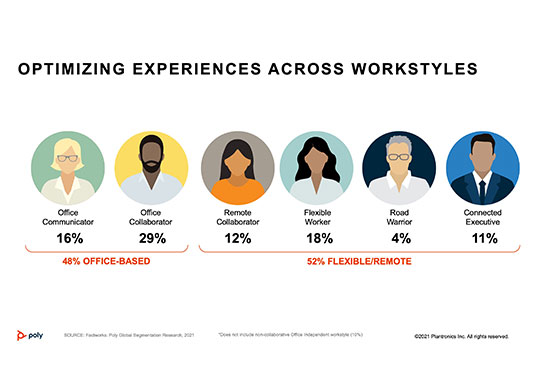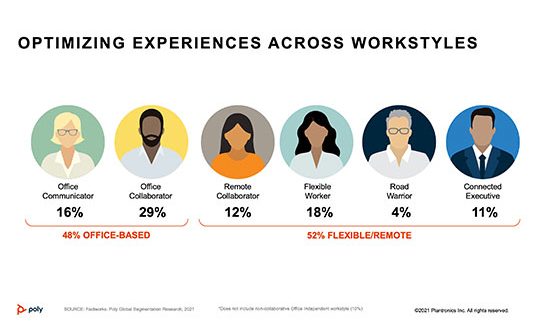
New research by Poly has identified six personas which represent approximately 92% of employees within a typical enterprise, each have their own distinct character traits. Through identifying the attributes, pain points, and communication preferences associated with each persona, businesses are better equipped to match workstyles and employee behaviours to devices and technologies, in turn increasing organisational productivity.
The six baseline personas and behaviours are:
OFFICE COLLABORATOR
Making up the largest proportion of the Australian workforce at 29%, these workers have a traditional office-based work style that is highly collaborative in nature and open to new technology. However, this brings with it background noise, constant disruptions, and a need to seamlessly manage their communication across devices.
In Australia, workers are most likely to be Office Collaborators, with fewer non-office-based staff than most other nations. This may be partly due to the lower impact that COVID has had in Australia, with fewer lockdowns. However, the research predicts a future decline in this type of worker persona underpinned by the uptick in their desire to work more flexibly.
FLEX WORKER
Splitting time between the corporate office, the home office, and travel, 18% of the Australian workforce is classified as a Flexible Worker. This persona is always innovating and adapting their communications channels due to their frequent remote and on-the-go work. They risk having difficulty collaborating with colleagues, and missing important information in the office, so they need to be “always-on,” and communicate across several devices to minimise this risk. The size of this persona group will likely grow as Office Collaborators who want to work more flexibly adapt to work at home, in the office and elsewhere.
REMOTE COLLABORATOR
With fewer opportunities for in-person meetings, the 12% of the Australian workforce who are Remote Collaborators face challenges including successful and productive collaboration. They need multiple devices and technologies to bridge the gaps between them and their colleagues, co-workers and clients. In the future, the number of Remote Collaborators is expected to increase, likely due to the number of Office Collaborators who choose to work remotely following COVID-19 pandemic.
OFFICE COMMUNICATOR
Office Communicators are most comfortable with familiar systems and devices such as a desk phone. They make up 16% of the Australian workforce and it is important to acknowledge their challenges such as being diverted by interruptions, background noise and lack of privacy on calls. More traditional workstyles went through a change during the pandemic, and this persona group is expected to remain stable in the short term as this is a group anxious to return to the office.
CONNECTED EXECUTIVE
These tech-savvy business drivers make up 11% of the Australian workforce. They go wherever needed to make decisions and solve problems. Versatile in their work style, they use more communication tools than any other persona. Their pain points include diversions, interruptions and unpredictable background noise as they need to stay connected across all devices. Executives need to connect will continue to be persistent due to which there will be a negligible effect on this persona type in the future.
ROAD WARRIOR
Accounting for 4% of the Australian workforce, Road Warriors are always on the move working outside of the office more than 50% of the time. They need highly portable and easy to use solutions that eliminate noise and reduce the chance of unreliable connections. Some people will still need to travel at times to complete the business tasks that require in-person contributions. This group size will remain stable as those who were prevented from travelling during COVID-19 get back out to see customers and colleagues.
The remaining 10% of employees not covered by the six personas fall under the Office Independent type. This includes people operating in self-directed roles with limited communication and collaboration technology needs.
Andy Hurt, ANZ MD at Poly, explains: “We have been studying workplace personas for almost a decade, but never has it been as crucial as it is now to truly understand the personality types within your business and how to get the best out of them. Whilst this study was conducted during COVID-19, we believe that the behaviour shifts observed in the workplace will remain long-term. Identifying these and ensuring that everyone has the correct tools and devices to maximise efficiency and productivity is the key to a successful and efficient workforce both now and for years to come.”





